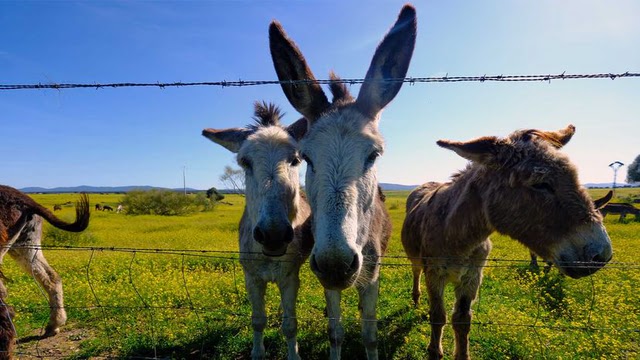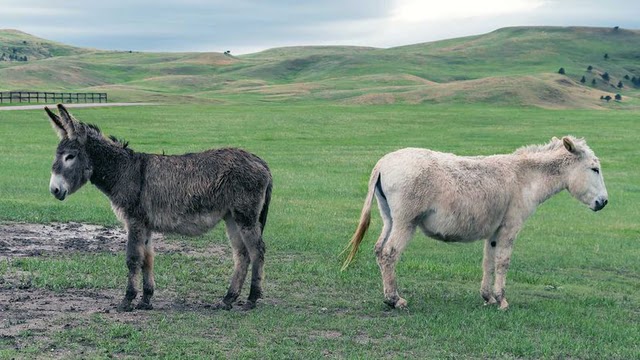Quck answer
Mules, burros, and jackasses are all related to donkeys, but they are not the same thing. A mule is a hybrid offspring of a male donkey and a female horse, while a burro is a small donkey that is often used as a pack animal. Jackass is another term for a male donkey. While all of these animals share similarities, they each have their own distinct characteristics and uses.
Wild Animals

Descendants of the African wild ass, donkeys are related to zebras and horses. Carlos Sanchez Pereyra/Getty Images
Although we often use the terms interchangeably, donkey, jackass, burro, and mule are not synonyms. Each word refers to a type of donkey, but a jackass is not a mule, and not all burros are jackasses.
So, what are these similar but distinct creatures within the equidae family? Let’s begin by examining the donkey.
A donkey is a domesticated animal that belongs to the horse family. Domestic donkeys, which descended from the African wild ass, have been used as pack animals since 4000 B.C.E. They are related to zebras and horses, but are typically stronger, stockier, and have distinct personalities.
Donkeys are not easily scared and do not panic when startled. Instead, they pause to assess the situation, which is often misunderstood as stubbornness. Their strength and surefootedness, combined with their ability to carry twice their body weight, make them ideal for carrying heavy loads. They are also used to protect sheep and cattle from predators such as dogs and coyotes. Once a donkey bonds with a herd of animals, it will defend them as if they were its own.
A jackass is simply a male donkey. The word “ass” comes from the Latin word “asinus,” which refers to the animal. While “ass” and “donkey” are interchangeable, “jackass” specifically refers to male donkeys. This term comes from the male donkey’s nickname “jack” and “ass.” Female donkeys are referred to as “jennies” or “jennets,” while a female ready to breed is called a “broodmare.”
A wild donkey is called a burro. “Burro” is the Spanish word for a common working donkey in Spain and Mexico. The term likely entered the English language in the U.S. when burros were brought to America’s southwest by Spaniards in the 1500s. Although burro is another name for donkey, the term has a more specific meaning. Those living west of the Mississippi River often use “burro,” while those to the east use “donkey.” Burro can also refer to smaller donkeys or wild donkeys roaming in California, Nevada, Arizona, Utah, and Oregon, according to the Bureau of Land Management.

When a male donkey and a female horse breed, they produce a mule.
Marcia Straub/Getty Images
What about mules? A mule is not just another name for a donkey. It is the offspring of a male donkey and a female horse. Mules are typically 35 to 70 inches (0.8 to 1.7 meters) tall and have a horse’s body and a donkey’s extremities. According to the Donkey Sanctuary, mules make sounds that are a combination of both parents, starting with a horse whinny and ending with a donkey’s hee-haw bray.
Personality-wise, mules exhibit traits of both parents and are often calm, steady, and strong. This is why riders often choose mules over horses for mountainous and steep terrain.
Interesting Fact: Donkeys Have Excellent Memories
Despite the popular saying that elephants never forget, donkeys also have remarkable memories. They can remember places and other donkeys they’ve encountered for up to 25 years.
In this article originally published on October 14, 2020, we provide some frequently asked questions (FAQ) about donkeys. For instance, while a mule may look like a horse with the extremities of a donkey, it is actually the offspring of a male donkey and a female horse. Mules inherit personalities from both parents, making them calm yet strong and steady.
Additionally, we explain that “jackass” is simply another name for a male donkey, and that when a male donkey mates with a female horse, the resulting offspring is a mule. Synonyms for donkeys include “jackass” and “burro,” the latter being a less common term used in certain regions of the United States to refer to small or wild donkeys.
FAQ
1. Are mules, burros, and jackasses all the same?
No, they are not the same. Mules are a hybrid breed created by breeding a male donkey and a female horse, while burros and jackasses are both common names for domesticated donkeys.
2. What is a mule?
A mule is a hybrid breed that is created by breeding a male donkey and a female horse. Mules are typically larger and stronger than donkeys and are known for their hardworking and patient nature.
3. What is a burro?
A burro is a domesticated donkey. Burros are smaller than horses and are often used as pack animals in arid regions.
4. What is a jackass?
Jackass is a common name for a male domesticated donkey. The term is also sometimes used to refer to donkeys in general.
5. Are burros and jackasses the same thing?
Yes, burros and jackasses are both common names for domesticated donkeys.
6. Can mules reproduce?
No, mules are sterile and cannot reproduce.
7. Are mules stronger than donkeys?
Yes, mules are typically larger and stronger than donkeys. They are also known for their endurance and hardworking nature.
8. What are some common uses for mules?
Mules are commonly used for transportation, farming, and logging due to their strength and endurance. They are also used in some sports, such as show jumping and dressage.
9. Can donkeys and horses mate?
Yes, donkeys and horses can mate to produce a mule. However, the offspring is always sterile and cannot reproduce.
10. Are donkeys endangered?
No, donkeys are not endangered. They are widely domesticated and can be found in many parts of the world.
11. What are some common misconceptions about donkeys?
One common misconception is that donkeys are stubborn and difficult to work with. However, this is not always the case and many donkeys are hardworking and patient. Another misconception is that all donkeys are the same, when in fact there are several different breeds with unique characteristics.





Leave a Reply